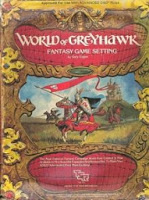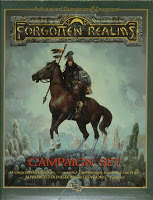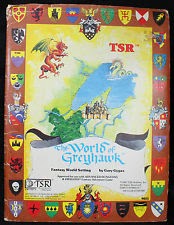For those of you who either use pre-made settings, or like to use them as idea mines, I’m wondering what it is you like, or dislike, about published campaign settings?
For instance, my beloved World of Greyhawk has gone through many different published iterations. The original folio is still considered to be a masterpiece of almost Hemingwayesque brevity. A few pages of the broad outline of history, a paragraph or two of description for each nation (with a few notable exceptions), and a line or two for most geographical features. That 32 page folio book and those two gorgeous poster maps by the talented Darlene were all there was. A minimum of detail, and those maps to inspire the DM to fill in the details through his own creativity.
 By today’s standards, I daresay it would be considered totally inadequate. A setting without mention of religion? No lists of NPCs? No adventure hooks? No diagrams of castles and maps of cities and regions? Unthinkable!
By today’s standards, I daresay it would be considered totally inadequate. A setting without mention of religion? No lists of NPCs? No adventure hooks? No diagrams of castles and maps of cities and regions? Unthinkable!
The gold box followed, with the same maps but adding a lot more detail, including weather, deities, encounter tables, and more. Then From the Ashes, which advanced the timeline, and included mini-adventures, And so forth. Each edition of Greyhawk filled in more and more detail.
The Wilderlands setting (which I knew at the time as the City-State campaign) from Judges Guild was almost the opposite. It was focused on the small-scale, and piecing together the shape, powers, and events of the bigger world from the smaller pieces was, to me, a difficult thing. I still loved it, though.
 My question is, though, what strikes you as the correct balance of detail and vagueness (for the DM to fill in himself)? Personally, I get turned off by settings that pile on tons and tons of obscure detail, to the point where only obsessive-compulsives and those without jobs or families to distract from reading everything that is published for the setting, can keep up. Forgotten Realms, I’m looking at you.
My question is, though, what strikes you as the correct balance of detail and vagueness (for the DM to fill in himself)? Personally, I get turned off by settings that pile on tons and tons of obscure detail, to the point where only obsessive-compulsives and those without jobs or families to distract from reading everything that is published for the setting, can keep up. Forgotten Realms, I’m looking at you.
Which is not to say that the FR doesn’t have its high points. The grey box was a masterpiece, managing to be both detailed and inspiring in a single stroke. But then the inexorable torrent of supplements and novels came at us like the undamed river Angren coming at Isengard. And to be fair, a lot of people really like that level of detail, knowing that wherever their players journey, the DM can just pick up the appropriate supplement off his shelf and have at it.
So what’s your detail-vs-vagueness sweet spot for settings? Are there features you look for? Things that turn you off? Must-haves?










Generally I prefer more brevity in a setting supplement–give me enough to get started, and I'm generally good. However, I do want to know about religion in a setting. It's just too important a factor in history and life to be ignored, no matter how "controversial" it is. This goes double for games that include religion as a character option (clerics and paladins)–I want to know what they are supposed to believe, at least as a baseline.
I have two major pet peeves, though. First, "metaplot." Can't stand it, don't care for it. I understand its appeal as a publisher, though, so all I ask is that you do it more like Mechwarrior than like White Wolf. Basically, allow a LONG period of time to pass between changes to the setting, and when you do change it, include the information in an easy place for the GM to see what's changed. I do not have the time or the desire to read every novel, adventure, and splat book to keep up with your plot while I'm busy trying to create my own.
Secondly, I hate whenever they describe something as "unknown." If the powerful city state was flooded and sank below the waters, people do now walk around saying it sank for unknown reasons. They have theories, and beliefs–most of which conveniently line up to their own prejudices. I'd rather hear about those theories than something being described as "unknown."
Basically, give me the rough information a fairly well educated individual in the world would know, and leave it at that. Oh, and if I could go through life never reading something written "in character" ever again, I would be able to die a happy man.
I shall demand to have my cake and to eat it likewise.
I either want the really broad strokes of the original folio (which I miss, and wish I had kept, but I was just a child when I owned it) or balls-out, every bit of minutia covered in fine detail. No half measures for me.
Adventure hooks and areas with unique adventuring opportunities. Not adventure module specific, but detailed enough to give your own creatively something to work with.
Stats for important enemy NPC's, if the setting is tied to a set of rules. Areas that are basically "shopping malls" for the characters don't need huge amounts of detail, just actionable material. Most of the demographic stuff doesn't appeal to me.
A few maps, an idea who lives there, what can I expect to find. I'll fill in the rest.
I am with you on this, Greyhawk is much more to my liking than the Realms.
I'm a Greyhawk folio kinda guy, myself.
Like Greyhawk Folio, but less breadth (fewer generic good-guy kingdoms) and more depth (info on religion, culture, society, not exhaustive but enough to hook into while leaving room for GM'sown content).
I'm not even sure any more. I think a lot of my personal reasons for enjoying the GM role, is to work on creating a campaign. So my vote would be none of the above.
If the setting could be presented in a very modular way… incomplete maps, unique ideas but presented in a general way, and "fill in the blank" areas.
Todd nailed it for me. Now if he can point me to a setting or two that actually thinks about religion, that would be just wonderful.
I love how in Kalamar, I can flip to a random page and find at least three "adventure hooks" (not entirely sure that's the right term), and someone else could flip to the same page and find completely different ones!
I've gotten pretty sick of fantasy pantheons, to be honest. I'd prefer weird mish-mashes of real-world ones, maybe with some fake ones thrown in here or there where appropriate. Then there's no need to explain religion to players of clerics. A setting could give some guidelines for what real-world religions are used or excluded, however
Absolutely NO advancing timelines! This was another thing I loved about Kalamar. If you really need to produce more content for a setting, I'd prefer more details about the current world than altering it with a series of events. Delving more into the Past is OK
If you're gonna give me minutiae, how 'bout some stuff I could actually use? Monster lairs could be pretty cool, and I don't recall ever seeing those listed (though I haven't looked into some older setting books like the Folio… yet)
I can't get enough random tables, so feel free to include as many as you'd like 😀
The Hobbit + Lord of the Rings + Silmarillion was just exactly the sum of information I needed to GM a ME campaign. All the published MERP were mood killers more than anything else (the maps were gorgeous thogh, so I might be inclined to keep them).
I suppose that this is the same things I expect from a setting (plus maybe some Random Encounter tables)
I like settings presented as numbered hexes: Here's a map overlaid with numbered hexes. At least some of the hexes have a short (one paragraph at most) point of interest. My own Isle of the Unknown uses this format.
Another option I like is a setting presented as random tables. Perusing the random tables gives you an idea of what the setting is like. Krshal uses this format.
Yet another option that I like is presenting the setting as supplemental rules: Here are the setting's races, classes, monsters, magic items, etc. Now distribute as you see fit! Carcosa was party done this way.
I do NOT like big walls of text in a setting book. Such things bore me.
First off, bravo to Todd Rokely. I can think of very little in his comment with which I would disagree.
Second, to Rachel Ghoul: Glorantha.
Finally, to address the primary question, I've given this matter quite a bit of thought, actually. In the end, I think that somewhere in between the Folio and the Gold Box is the perfect level of detail for a published product. The encounter tables of the boxed set are a brilliant and concise way of presenting the world background in a way that correlates with what the players' characters might actually experience. On the other hand, the weather charts were unnecessary (and being an abbreviation of the source article didn't help matters; not to mention that the source article has a few problems that remain unaddressed). I think that an "order of battle", perhaps such as was presented in the "Events of the Flanaess" article series, would be a very useful addition for some sorts of campaigns.
I like a little detail on a lot of things. Greyhawk often offers that, so does Dark Sun. Too much information just becomes fluff I will never use.
faoladh: Second time this week I've had Glorantha recommended to me. Isn't it pretty tied up with Runequest, though?
Rachel Ghoul: At one time, the only ways to explore Glorantha were through a couple of wargames (Dragon Pass and White Bear, Red Moon are the two I remember) and the RPG RuneQuest. Since RQ was separated from Glorantha by Avalon Hill in one of the biggest blunders of the industry, people have adapted Glorantha to various other rule sets. One of the most popular is called PenDragon Pass, and adapts the Pendragon rules to Glorantha. The official RPG is currently split into two different rule sets, RQ (which is mainly to use the earlier material and due to player demand) and HeroQuest, which is a "story first" style game.
And anyway, RQ is just a heavily house-ruled D&D, developing in part from the Perrin Conventions.
I actually find this a very difficult question to answer. The Greyhawk folio was my first introduction to settings, and in some ways that's still my benchmark. But I suspect that I would find it too minimalist these days. Isn't the purpose of a setting to give the DM enough information so that he/she doesn't have to invent everything? What I recall from Greyhawk (it's in storage somewhere), is that I'd find myself having to do a ton of mapping and thinking about stuff so as to make it come alive. Yet, on the other hand, I really have little truck with the massively detailed settings. Yggsburgh, for instance, is really too detailed for me. I think this is what i'd want in a setting: 1) greyhawk-style overviews of political groupings (states?) and supra-national organizations; 2) JG-style adventure hooks imagined on a scale of breadth-specificity: so, some that worked between states, some within states, some within cities, some set in particular geographic regions, and some in very localized areas; 3)a medium level of detail in major cities. By medium I mean the most important institutions, buildings, and persons, with samples of typical shops. What I don't need is every shopkeeper or street fully detailed; 4) some judiciously chosen and presented culture for some of the areas, perhaps in tabular form. I don't want to read treatises on law, or songs, etc, nor do I want them in some NPC's 'voice' [gahhh!], but I do want some things that I can use for flavor. So, for instance, the Four Cardinal Vices of the Gelladean Empire, or something. This should be purposefully incomplete (so as to not be overwhelming), but still broad enough to be of use. So, like Jason Packer said, I want my cake (flavor) and want to eat it as well (not too much flavor).
Just as a general follow-up question to all: what do you think of having separate books for the GM and the players? The former would have all the in-depth information, while the latter would have what would be common knowledge, information about classes and races, etc.
I haven't really seen this before, though my experience could be limited. In theory, it sounds great! Pretty much my favorite thing Pathfinder does is come out with these brief player primers for their Adventure Paths. While not a huge fan of the AP's myself, having these primers is great for making characters that fit into the world, and for inspiring the players to come up with neat (and setting appropriate) goals.
Not to be snarky, but I see this said fairly frequently
"RQ is just a heavily house-ruled D&D"
It has HP and uses dice, but it is really completely different.
No classes, skill based, HP don't increase, point based magic, that feels nothing like D&D magic. Armor decreases damage vice makes you harder to hit, no exp points, etc etc.
To the Follow-up.
If you have to explain the setting in detail beforehand to the players rather than through play, base the setting on a novel and have the players read that instead.
The setting explanation shouldn't take more than 5 minutes during the character generation, which is the maximum attention span of a player while listening to the DM droning on.
Michael: That's fair enough, but what I meant is what I said. RQ starts from the assumptions of D&D, then makes many changes to the way those are modeled in the rules, without changing the assumptions, to result in its final form (and, as the Perrin Conventions show, those changes had definite historical roots in D&D). By comparison, Dogs in the Vineyard (to choose one example) or HeroQuest (to choose a perhaps more immediately relevant one) completely rejects many or even all of the assumptions of D&D, replacing them with an entirely different sort of logic.
On the follow-up question: Sure! Either that or separate sections of a single book. Though, I suppose that items given as rumor or contested theories from within the game setting should probably be left unresolved for the Referee to make a final decision about relevant to her own campaign.
I like the idea of separate books in theory. Yet sometimes it's hard to get players to read stuff, even 1-page handouts. It really depends on the group, I think. A couple of my players would probably dabble in a players' guide to a setting, but most would not take the time.
As to the followup, I think that's a good model. D&D 4e did that, at least up until Dark Sun, and I thought they were onto something with it.